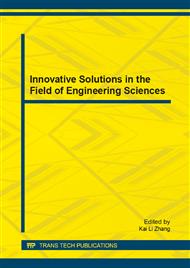[1]
SHUAI Chungang, DUAN Yonggang, RAN Lin et. al. Research on the method of controlling bottom water with Inflow Control Devices (ICD) in horizontal well [J] Oil Drilling & Production Technology, 2012, 34(1); 85-88.
Google Scholar
[2]
XIONG Chunming, Tang Xiaofen, Technologies of water shut-off and profile control: An overview[J] Petroleum Exploration and Development, 2007, 1.
Google Scholar
[3]
KABIR Akim. Accurate inflow profile prediction of horizontal wells through coupling of a reservoir and wellbore simulator[R]. SPE 119095, (2008).
DOI: 10.2118/119095-ms
Google Scholar
[4]
AL-AHMADI H A, Al-MUTARI S M. Effective water production control through utilizing ECP and passive ICD completion technologies: case histories[R]. SPE120822, (2008).
DOI: 10.2118/120822-ms
Google Scholar
[5]
Fang Quan tang, Zhang Feng li et. al. Analyses of Influencing Factors and Mechanism of Controlling Bottom Water in Horizontal Well with Inflow Control Device[J]Journal of Southwest Petroleum University(Science & Technology Edition). 2012. 6.
Google Scholar
[6]
BIRCHENKO V M, AL-KHELAIWI F T, KONOPCZYNSKI M R, et al. How to make a choice between passive and active inflow-control completions[C]. paper 115742-MS presented at the SPE Annual Technical Conference and Exhibition, (2008).
DOI: 10.2118/115742-ms
Google Scholar
[7]
F.T. Alkhelaiwi, D.R. Davies. Inflow Control Devices: Application and Value Quantification of a Developing Technology [R]. SPE 108700, (2007).
Google Scholar
[8]
PolinaMinulina, Shahin AI-Sharif, GerogeZeito, et al. The Design, Implementation and Use of Inflow Control Devices for Improving the Production Performance of Horizontal Wells[C]. paper 157453-MS presented at the SPE International Production and Operations Conference and Exhibition held in DohaQatar, (2012).
DOI: 10.2118/157453-ms
Google Scholar
[9]
PrestonFernandes, Zhuoyi Li, D. Zhu. Understanding the Roles of Inflow-Control Devices in Optimizing Horizontal-Well Performance[C] paper 124677-MS presented at the 2009 SPE Annual Technical Conference and Exhibition held in New Orleans, Louisiana, USA 4-7 October (2009).
DOI: 10.2118/124677-ms
Google Scholar
[10]
Garcia Luis. Inflow Control Device (ICD) Performance Testing. Test Report No. 1A1-166-02C. (2008).
Google Scholar
[11]
F T ALKHELAIWI, SAUDI ARAMCO, D R DAVIES. Inflow control devices: Application and value quantification of a developing[C]. Paper 108700 presented at the SPE International Oil Conference and Exhibition, (2007).
Google Scholar
[12]
Zhang Lei, Pan Hao. Application of Stabilizing Oil Production Controlling Water Cut Technique in Horizontal Well for Pre-developing with Bottom Water Reservoir [J]. Journal of Chong qing University of Science and Technology : Natural Science Edition2012. 5.
Google Scholar


